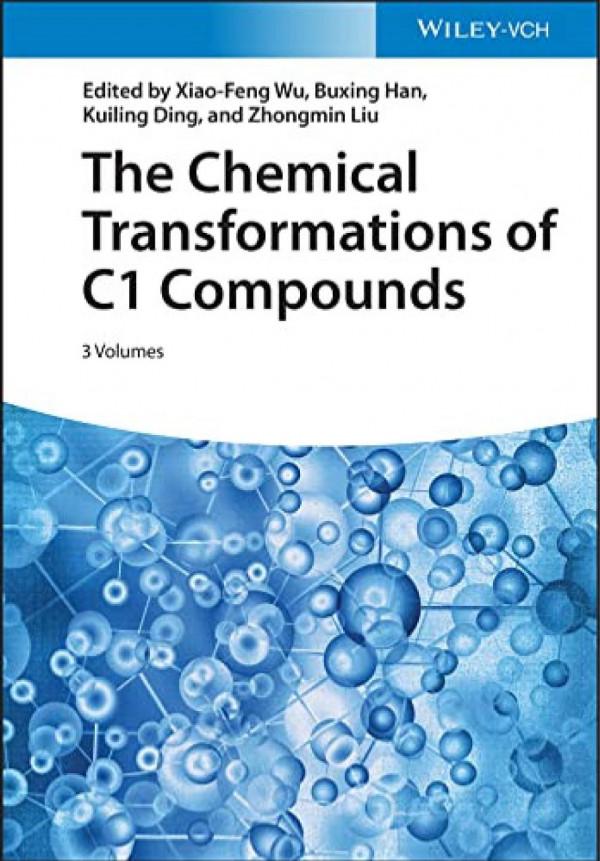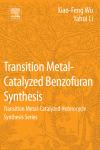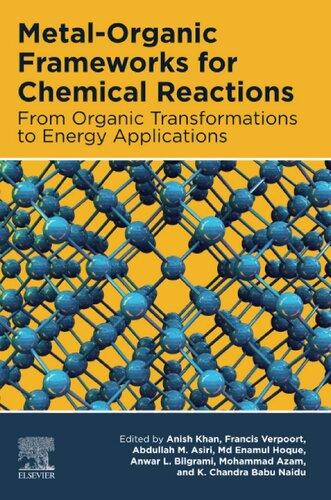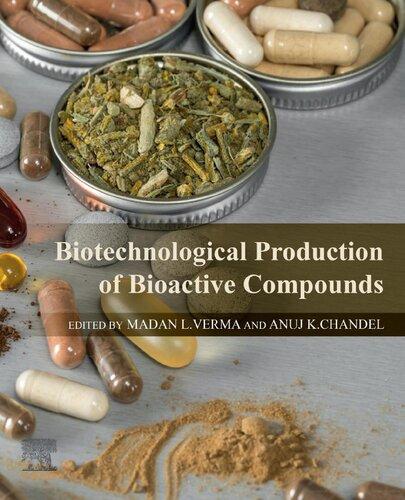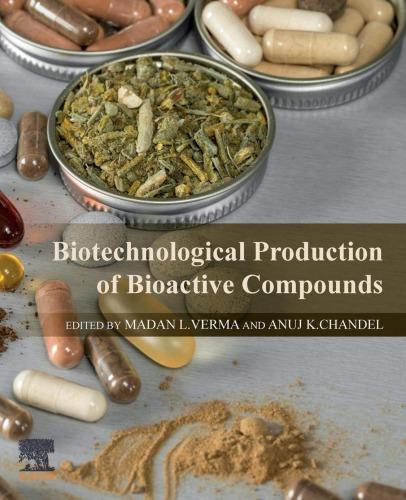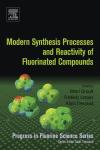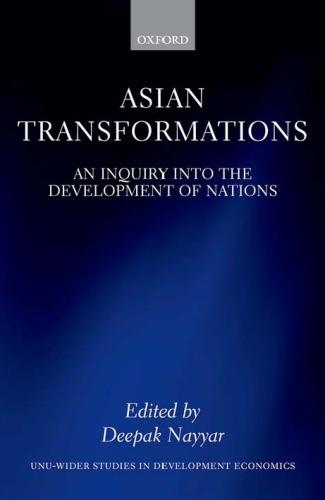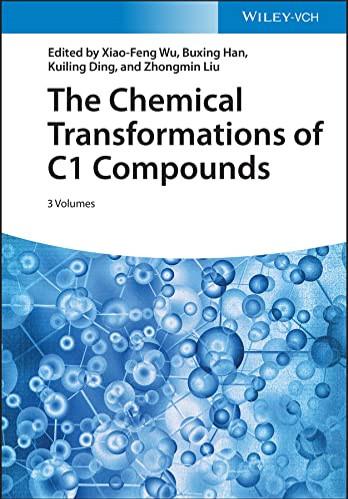The Chemical Transformations of C1 Compounds 1st Edition Xiao-Feng Wu Visit to download the full and correct content document: https://ebookmass.com/product/the-chemical-transformations-of-c1-compounds-1st-e dition-xiao-feng-wu/
More products digital (pdf, epub, mobi) instant download maybe you interests ...
Transition Metal-Catalyzed Benzofuran Synthesis 1st
Edition Xiao-Feng Wu
https://ebookmass.com/product/transition-metal-catalyzedbenzofuran-synthesis-1st-edition-xiao-feng-wu/
Metal-Organic Frameworks for
Chemical Reactions: From Organic Transformations to Energy Applications 1st Edition Anish Khan (Editor)
https://ebookmass.com/product/metal-organic-frameworks-forchemical-reactions-from-organic-transformations-to-energyapplications-1st-edition-anish-khan-editor/
Biotechnological Production of Bioactive Compounds 1st
Edition Madan L. Verma (Editor)
https://ebookmass.com/product/biotechnological-production-ofbioactive-compounds-1st-edition-madan-l-verma-editor/
Biotechnological production of bioactive compounds
Chandel
https://ebookmass.com/product/biotechnological-production-ofbioactive-compounds-chandel/
Life C1 Advanced 2nd Edition Paul Dummett
https://ebookmass.com/product/life-c1-advanced-2nd-edition-pauldummett/
Mathematical Foundation of Fuzzy Sets 1st Edition Hsien-Chung Wu
https://ebookmass.com/product/mathematical-foundation-of-fuzzysets-1st-edition-hsien-chung-wu/
The People’s Dance: The Power and Politics of Guangchang Wu 1st ed. Edition Rose Martin
https://ebookmass.com/product/the-peoples-dance-the-power-andpolitics-of-guangchang-wu-1st-ed-edition-rose-martin/
Modern Synthesis Processes and Reactivity of Fluorinated Compounds 1st Edition Edition Groult Henri. (Ed.)
https://ebookmass.com/product/modern-synthesis-processes-andreactivity-of-fluorinated-compounds-1st-edition-edition-groulthenri-ed/
Asian Transformations: An Inquiry into the Development of Nations 1st Edition Deepak Nayyar (Eds.)
https://ebookmass.com/product/asian-transformations-an-inquiryinto-the-development-of-nations-1st-edition-deepak-nayyar-eds/
TheChemicalTransformationsofC1Compounds TheChemicalTransformationsof C1Compounds Volume1
Editedby
Xiao-FengWu,BuxingHan,KuilingDing,andZhongminLiu
TheChemicalTransformationsof C1Compounds Volume2
Editedby
Xiao-FengWu,BuxingHan,KuilingDing,andZhongminLiu
TheChemicalTransformationsof C1Compounds Volume3
Editedby
Xiao-FengWu,BuxingHan,KuilingDing,andZhongminLiu
Editors
Prof.Dr.Xiao-FengWu
DalianNationalLaboratoryforClean Energy
DalianInstituteofChemicalPhysics
ChineseAcademyofSciences 116023Dalian Liaoning,China
Leibniz-InstitutfürKatalysee.V. Albert-Einstein-Straße29a 18059Rostock Germany
Prof.Dr.BuxingHan InstituteofChemistry
ChineseAcademyofSciences No.21stNorthStreet Zhongguancun 100190Beijing China
Prof.Dr.KuilingDing ShanghaiInstituteofOrganicChemistry ChineseAcademyofSciences 354FenglinRoad ChineseAcademyofSciences 200032Shanghai China
Prof.Dr.ZhongminLiu ChineseAcademyofSciences
DalianInstituteofChemicalPhysics 457ZhongshanRoad 116023Dalian China
CoverDesign: Wiley CoverImage: ©SommaiLarkjit/Getty
Allbookspublishedby WILEY-VCH arecarefully produced.Nevertheless,authors,editors,and publisherdonotwarranttheinformationcontained inthesebooks,includingthisbook,tobefreeof errors.Readersareadvisedtokeepinmindthat statements,data,illustrations,proceduraldetailsor otheritemsmayinadvertentlybeinaccurate.
LibraryofCongressCardNo.: appliedfor
BritishLibraryCataloguing-in-PublicationData Acataloguerecordforthisbookisavailablefrom theBritishLibrary.
BibliographicinformationpublishedbytheDeutsche Nationalbibliothek
TheDeutscheNationalbibliothekliststhis publicationintheDeutscheNationalbibliografie; detailedbibliographicdataareavailableonthe Internetat <http://dnb.d-nb.de>.
©2022WILEY-VCHGmbH,Boschstr.12,69469 Weinheim,Germany
Allrightsreserved(includingthoseoftranslation intootherlanguages).Nopartofthisbookmaybe reproducedinanyform–byphotoprinting, microfilm,oranyothermeans–nortransmittedor translatedintoamachinelanguagewithoutwritten permissionfromthepublishers.Registerednames, trademarks,etc.usedinthisbook,evenwhennot specificallymarkedassuch,arenottobe consideredunprotectedbylaw.
PrintISBN: 978-3-527-34895-4
ePDFISBN: 978-3-527-83187-6
ePubISBN: 978-3-527-83189-0
oBookISBN: 978-3-527-83188-3
Typesetting Straive,Chennai,India PrintingandBinding
Printedonacid-freepaper 10987654321
1DirectConversionsofMethaneviaHomogeneous Processes 1 HuiChen,AnhuaHu,LiangChang,QingAn,HuiPan,andZhiweiZuo
1.1Introduction 1
1.2FormationofMethanolandItsDerivatives 2
1.2.1ElectrophilicActivation 2
1.2.2Radical-MediatedActivation 9
1.3FormationofAceticAcid 11
1.3.1K2 S2 O8 Oxidant-BasedSystems 12
1.3.2O2 Oxidant-BasedSystems 14
1.3.3H2 SO4 Oxidant-BasedSystems 15
1.3.4OtherOxidant-BasedSystems 17
1.4FormationofMethanesulfonicAcid 17
1.5FormationofBorylatedProducts 19
1.6FormationofAminatedProducts 21
1.7FormationofAlkylatedProducts 23
1.8SummaryandConclusions 24
References 26
2ChemicalTransformationsofMethanol 31 ZhengkaiChenandXiao-FengWu
2.1Introduction 31
2.2Methylation 31
2.2.1C-Methylation 32
2.3N-Methylation 42
2.4Hydroxymethylation 49
2.5N-Formylation 51
2.6Methoxylation 54
2.7TheReactionsUsingMethanolastheC1Source 62
2.8Conclusions 65 References 65
3SynthesisofOlefinsfromCH3 OH 71
WennaZhang,YingxuWei,andZhongminLiu
3.1Introduction 71
3.2CatalystsofMethanoltoOlefins 73
3.2.1ZSM-5CatalystwithMFITopologyStructure 73
3.2.2SAPO-34withCHATopologyStructure 73
3.2.3OtherCatalystswith8-MRPoreOpeningandCavityStructure 76
3.3CatalyticReactionMechanismofMethanolConversion 77
3.3.1ReactionCourseofMTOProcess 77
3.3.2DirectMechanismofMethanolConversion 78
3.3.2.1Carbonylation-BasedMechanism 79
3.3.2.2MethoxymethylCarbocationMechanism 81
3.3.2.3Methane-formaldehydeMechanism 81
3.3.2.4Extra-FrameworkAluminum-Assisted(EFAL)InitialC—CBond Formation 83
3.3.2.5OxoniumIon-ylideMechanism 85
3.3.2.6SMS/TMO-mediatedDME/MethanolActivationMechanism 88
3.3.3AutocatalysisCharacterofMethanolConversion 88
3.3.4IndirectMechanismofMethanolConversion 90
3.3.4.1HydrocarbonPoolMechanism 91
3.3.4.2Dual-cycleMechanism 97
3.3.4.3Cyclopentadienes-BasedCycle 100
3.3.5EvolutionfromDirectMechanismtoIndirectMechanism 102
3.3.6ReactionNetworkofMTOProcess 105
3.4DeactivationofMTOReaction 107
3.4.1Low-temperatureDeactivationMechanismofSAPO-34inMTO Reaction 108
3.4.2High-temperatureDeactivationMechanismofSAPO-34inMTO Reaction 109
3.4.3ACage-passingGrowthDeactivatingModelonSAPO-34 112
3.5DMTOProcessDevelopments 115
3.5.1Scale-upSynthesisofDMTOCatalyst 115
3.5.2IndustrialTestofDMTOTechnology 115
3.5.3DMTOTechnologyCommercialization 117
3.5.4DMTO-IITechnology 117
3.5.5DMTO-IIITechnology 118
3.6ConclusionsandOutlook 119 Acknowledgments 119 References 119
4CarbonylationofMethanol:AVersatileReaction 127 DipakK.Dutta
4.1Introduction 127
4.2CarbonylationofMethanoltoProduceAceticAcid 131
4.2.1IndustrialProcesses 131
4.2.1.1TheCobalt-BasedBASFProcess 131
4.2.1.2Rhodium-Catalyst-BasedMonsantoCarbonylationProcess 132
4.2.1.3TheIridium-BasedCativaProcessofBPChemicals 135
4.2.2LaboratoryProcesses 137
4.2.2.1HomogeneousCatalysts 137
4.3ConclusionandFutureAspects 151 Acknowledgments 152 References 152
5FormaldehydeasC1SynthoninOrganicSynthesis 157
WanfangLiandXiao-FengWu
5.1Introduction 157
5.2FormaldehydeasMethylenes(–CH2 –) 159
5.2.1MethylenesLinkingTwoArylGroups 159
5.2.2MethylenesLinkingTwoAlkylGroups 165
5.2.3MethylenesLinkingCarbonandNitrogen 167
5.2.3.1Mannich-TypeReactions 167
5.2.3.2FormationofPropargylAmines 167
5.2.3.3SynthesisofAllylandBenzylAmines 172
5.2.4MethylenesLinkingCarbonandOxygen 176
5.2.4.1Oxa-Pictet–SpenglerReaction 176
5.2.4.2FormationofPropargylAlcohols 178
5.2.5MethylenesLinkingCarbonandHalogens 179
5.2.6MethenynationReactions(=CH2 ) 180
5.2.6.1FormationofTerminalAllenes 180
5.2.6.2MethenynationofAllylicandBenzylicPositions 182
5.2.6.3MethylenynationofCarbonylsviaWittigReaction 183
5.2.6.4 α-MethylenynationsofCarbonyls 184
5.2.7MethylenenLinkingTwoHeteroatoms 185
5.3HydroxymethylationReagent(–CH2 OH) 192
5.3.1HydroxymethylationofCarbonylSubstrates 192
5.3.2PrinsandCarbonyl-EneReactionswithFormaldehyde 199
5.3.3Morita–Baylis–HillmanReactionwithFormaldehyde 205
5.3.4ReductiveHydroxymethylationofAlkenesandAlkynesAllenes 206
5.3.5HydromethoxylationofOrganometallics 211
5.3.6HydromethylationofMiscellaneousCompounds 213
5.4AsCOSource 217
5.4.1CarbonylationReactions 217
5.4.1.1CarbonylationofArylHalides 217
5.4.1.2CarbonylationofAlkenesandAlkynes 220
5.4.2HydroformylationsReactions 223
5.4.3FormaldehydeforKetoneSynthesis 227
5.5AsHydrogenDonorandAccepter 227
5.6AsMethylationandFormylationReagents 230
5.6.1MethylationReagent 230
5.6.2FormylationReagent 232
5.7FormaldehydeasLigandandReductantinOrganometallic Chemistry 234
5.8SummaryandOutlook 235 References 236
6OrganicTransformationsofHCO2 H 249 ZhipingYinandXiao-FengWu
6.1Introduction 249
6.2ProvidingCarbonylMoiety 249
6.2.1ReactionswithArylHalidesorTriflates 250
6.2.2ReactionswithAlkenesorAlkynes 254
6.2.3ReactionswithAmines 256
6.3ProvidingCarboxylMoiety 257
6.3.1ReactionswithArylHalides 257
6.3.2ReactionswithArenes 258
6.3.3ReactionswithAlkenesorAlkynes 260
6.4AsHydrogenSource 263
6.4.1ReducingAlkenesorAlkynes 263
6.4.2ReducingCarbonylGroups 268
6.4.3HydrogenolysisBenzylicC—OBonds 272
6.4.4ReducingNitroGroups 275
6.4.5ReducingUnsaturatedC—NBonds 278
6.5OtherReactions 281
6.6Conclusion 283 References 283
7TheMultifunctionalMaterialsforHeterogenous Carboxylation:FromFundamentalUnderstandingtoIndustrial Applications 289 YunjieDing,LiYan,andXiangenSong
7.1Introduction 289
7.2HydroformylationofOlefins 289
7.2.1HeterogeneousHydroformylation 290
7.2.1.1HydroformylationofEthylene 290
7.2.1.2HydroformylationofPropene 292
7.2.1.3HydroformylationofButenes 293
7.2.1.4HydroformylationofLong-ChainOlefins 298
7.2.1.5AsymmetricHydroformylation 301
7.3HeterogeneousCarbonylation 303
7.4OtherCatalyticReactions 307
7.4.1AsymmetricHydrogenation 307
7.4.2Alkoxycarbonylation 308
7.4.3Suzuki–MiyauraCouplingReactions 311
7.4.4OxidativeHeckReaction 312
7.4.5Hydrogenation 313
7.4.6ChemoselectiveDecarbonylationofAldehydes 315
7.4.7CyclicAdditionReactionofCO2 andEpoxides 315
7.5SummaryandPerspective 319
Acknowledgments 319
ConflictofInterest 319 References 319
8RecentHydrocarbonylationofUnsaturatedHydrocarbonswith HomogeneousCatalyst 325
KaiwuDongandKuilingDing
8.1Introduction 325
8.2TransitionMetal-CatalyzedHydroformylation 327
8.2.1Cobalt-CatalyzedHydroformylation 328
8.2.2Rhodium-CatalyzedHydroformylation 332
8.2.3Ruthenium-CatalyzedHydroformylation 352
8.2.4Iron-,Osmium-,andIridium-CatalyzedHydroformylation 357
8.2.5Metal-FreeHydroformylation 360
8.3TransitionMetal-CatalyzedHydrocarbonylation (ReppeCarbonylation) 361
8.3.1Palladium-CatalyzedHydrocarbonylation 361
8.3.1.1Palladium-CatalyzedHydrocarbonylationofAlkenes 361
8.3.1.2Palladium-CatalyzedEnantioselectiveHydrocarbonylationof Alkenes 383
8.3.1.3Palladium-CatalyzedHydrocarbonylationofAlkynes 386
8.3.1.4Palladium-CatalyzedHydrocarbonylationofInSituGenerated Alkenes 393
8.3.2Nickel-CatalyzedHydrocarbonylation 395
8.3.3Ruthenium-andPlatinum-CatalyzedHydrocarbonylation 397 Acknowledgments 399 ListofAbbreviations 399 References 400
9CarbonylationofC(sp2 )—XBonds 415 HuaanziHu,JianLiu,andQiangZhu
9.1Introduction 415
9.2CommonAspects 415
9.2.1TypesofC(sp2 )—X 416
9.2.1.1Aryl/VinylHalides 416
9.2.1.2Aryl/VinylPseudohalides 417
9.2.2CatalystsorInitiators 418
9.2.2.1NobleMetalCatalysts 418
9.2.2.2Non-NobleMetalCatalysts 420
9.2.2.3PhotoinitiatedRadicalProcess 421
9.2.2.4OtherRadicalProcess 425
9.2.3COSources 425
x Contents
9.2.3.1MetalCarbonylComplex 426
9.2.3.2FormicAcidandItsDerivatives 426
9.2.3.3Others 428
9.2.3.4TheTwo-ChamberSystem 431
9.2.4Nucleophiles 431
9.3DominoCarbonylations 434
9.3.1IntramolecularDominoCarbonylations 434
9.3.2IntermolecularDominoCarbonylations 436
9.4DoubleCarbonylations 438
9.4.1AdjacentCarbonylGroups 439
9.4.2NonadjacentCarbonylGroups 441
9.5AsymmetricCarbonylations 442
9.6Applications 445
9.6.1SynthesisofHeterocycles 445
9.6.2DrugsorNaturalProducts 448 References 452
10CarbonylationofC(sp3 )—XBondsUtilizingCO 459 RenyiShiandAiwenLei
10.1Introduction 459
10.2CarbonylationofAllylCompounds 460
10.2.1AllylMetallicReagents 460
10.2.2AllylHalides 464
10.2.3AllylEsters 466
10.2.4AllylEthers 472
10.2.5AllylAlcohols 473
10.2.6AllylAmines 477
10.3CarbonylationofBenzylicCompounds 477
10.3.1BenzylHalides 477
10.3.2BenzylAlcohol 487
10.3.3BenzylAmines 490
10.3.4Benzyl-H 491
10.3.5Others 492
10.4 α-CarbonylationofCarbonylDerivatives 493
10.4.1 α-HalideCarbonylDerivatives 493
10.4.2 α-HCarbonylDerivatives 494
10.4.3Other 494
10.5CarbonylationofAliphaticAlkylCompounds 495
10.5.1AlkylMetallicReagents 495
10.5.2AliphaticAlkylHalides 496
10.5.3CarbonylationofHeterocycles 503
10.5.4AliphaticC—HBonds 510
10.6Conclusion 515 References 516
11CarbonylativeC—HBondActivation 533
AngelaKaiserandBruceA.Arndtsen
12RecentAdvancesinRadicalCarbonylation 567
ShuheiSumino,TakahideFukuyama,andIlhyongRyu
13AsymmetricCarbonylationReactions 611
Shao-TaoBai,JialinWen,andXumuZhang
14CarbonylativeSynthesisofDPC(DiphenylCarbonate) 667 RaffaellaMancusoandBartoloGabriele
15OxidativeCarbonylationofAmines 687 YanweiCao,LinHe,andChunguXia
16CarbonylationofNitroarenesandRelatedCompounds 721 FabioRagainiandFrancescoFerretti
17Zeolite-CatalyzedCarbonylationofDimethylEther 763 EnshengZhan,ZhipingXiong,andWenjieShen
18ComplexNaturalProductTotalSynthesesFacilitatedby Palladium-CatalyzedCarbonylativeCyclizations 793 YiyangLuo,LeiLi,andMingjiDai
19Metal-CatalyzedAlternatingPolymerizationReactionswith CarbonMonoxide 827
WernerOberhauser
20COHydrogenation 861
JingtingHu,WeiZhou,KangCheng,QinghongZhang,andYeWang
21CarboxylationwithCarbonDioxideasaC1Sourcevia Carbon–CarbonBondFormingReactions 909 TetsuakiFujihara
22CyclizationReactionswithCO2 973
ArjanW.Kleij
23ReductionofCO2 toFormicAcid 1003
BernardB.A.Bediako,QingliQian,andBuxingHan
24ReductionofCO2 toCOandTheirApplications 1027
KarolineT.Neumann,AnneK.Ravn,MartinB.Johansen,AskeS.Donslund, MagnusH.Rønne,HaraldurG.Gudmundsson,andTroelsSkrydstrup
25HydrogenationofCO2 toChemicalswithGreen Hydrogen 1073
FengSha,XinyiLiu,ShanTang,JijieWang,andCanLi
26MethylationReactionswithCO2 1185
Xiang-YangYao,Zhi-WenYang,Hong-RuLi,andLiang-NianHe
27UsingCO2 as–CH–and–CH2 –Sources 1217
Xiao-WangChen,Yong-YuanGui,Yuan-XuJiang,KeJing,Ya-NanNiu, Yue-MingJiang,andDa-GangYu
28CatalyticAsymmetricTransformationofCO2 1265
FachaoYan,Jian-FeiBai,andYuehuiLi
29PolymerizationReactionswithCO2 1305 Wen-BingLiandXiao-BingLu
30Transition-Metal-CatalyzedC–CNCross-Coupling 1337 MuruganDhanalakshmiandPazhamalaiAnbarasan
31RecentAdvancementinTransition-Metal-Catalyzed HydrocyanationofNonpolarUnsaturatedCompounds 1367 RongrongYu,KaiwuDong,andXianjieFang
32OrganicTransformationswithMeNO2 1397 DebaratiDas,NilamPatil,andBhalchandraM.Bhanage
33ApplicationsofDMFasaReagentinOrganicSynthesis 1439 ZechaoWangandXiao-FengWu
34AdvancesintheSynthesisofMethylatedProductsThrough DirectApproaches:AGuideforSelectingMethylation Reagents 1475 YantaoChen
35OrganicTransformationswithDCM,CCl4 ,CHCl3 ,andCHBr3 andOtherRelatedReactions 1577 YunyunLiuandJie-PingWan
36TrifluoromethylationwithCF3 IandOtherRelated Reagents 1609 Xiu-HuaXuandFeng-LingQing
37TheApplicationsofDimethylSulfoxideasaOne-Carbon SourceinOrganicSynthesis 1647 Chong-LiangLiandXiao-FengWu
1667
DirectConversionsofMethaneviaHomogeneousProcesses HuiChen,AnhuaHu,LiangChang,QingAn,HuiPan,andZhiweiZuo
ShanghaiTechUniversity,SchoolofPhysicalScienceandTechnology,393MiddleHuaxiaRoad,Shanghai 201210,China
1.1Introduction Naturalgasistypicallyviewedasacleanenergyfuelandaneconomicalchemical feedstockbythechemicalcommunity.Withdwindlingoilsuppliesandthegrowing importanceofreducingtheworldwidedependenceonpetroleum-basedchemical products,therecentdiscoveryofunconventionalreservoirswithlargevolumeshas madeitaneconomicallyattractiverawmaterial.Inadditiontothedirecteconomic gainfromthemakingofvalue-addedchemicalproducts,theupgradingofnatural gasintoliquidchemicalsalsocouldhelpreducethecapitalandemissioncostsofthe long-rangetransportationofnaturalgas.Withmoreandmorecountriesandsocietiescommittingtocarbonneutralityintheforthcomingyears,thedevelopmentof innovativeandeffectivemeansofutilizingthisabundantnaturalresourceformore sustainablechemicalproductionhasbecomeurgent.
Methaneisthemainchemicalcomponentofnaturalgas,andthus,thedirect transformationofmethaneintohigh-valueliquidcommoditychemicalshas attractedenormousamountsofresearchattentionacrossthescientificcommunity overthepastfewdecades[1–8].Nevertheless,thecentralchallengeofmethane functionalizationliesinitslowintrinsicreactivity.Thehomolyticbonddissociation energy(BDE)oftheC—Hbondsinmethaneis105kcal/mol,whichisthehighest amongallofthealkanes,indicatingthatmethaneistheleastreactivelightalkane [9].Inaddition,becauseofmethane’shighionizationpotentialof12.6eV,electron affinityof1.5eV,highpK a of50indimethylsulfoxide(DMSO),andprotonaffinity of132kcal/mol,directconversionsofmethaneinvolvingelectrontransferand protontransferareunfavorable.Besides,thegaseouspropertyofmethaneleadsto itslowsolubilityinmostreactionsolvents(e.g.methanehasa1mMsolubilityin waterat1atmand25 ∘ C),whichrendersthereactionconcentrationofmethane insolutiondisadvantageous.Moreover,theintroductionofanyfunctionalgroups canresultinmoreactivatedC—Hbondsintheproducts,souniqueselectivityfor themethaneC—Hbondshastobeachieved.Despitethesechallenges,tremendous
TheChemicalTransformationsofC1Compounds,FirstEdition. EditedbyXiao-FengWu,BuxingHan,KuilingDing,andZhongminLiu. ©2022WILEY-VCHGmbH.Published2022byWILEY-VCHGmbH.
1DirectConversionsofMethaneviaHomogeneousProcesses
progresshasbeenmadeintheC–Hfunctionalizationofmethaneusingtransition metalcatalystssuchasPt,Pd,andHg[9].Nevertheless,thepracticaldemands ofindustrialdevelopmenthaveimposedseverechallengesontheutilizationof coeffectivecatalystsandreagentsandonecologicallybenignconditionsforthe developmentofhighlyefficientandselectiveC(sp3 )—Hbondfunctionalizations, constantlydrivingthedevelopmentofcatalyticstrategies.
Inthischapter,wesummarizedtheadvancementsinthedirectconversion ofmethanethroughahomogeneousprocess.Notably,tremendousprogress hasbeenachievedintheheterogeneousresearchfield[10–12],andithasbeen well-documentedelsewhere;therefore,itisnotincludedhere.Tofurtherhighlight thepracticalsignificanceofhomogenouscatalyticplatformsinmethaneC–H functionalizations,meanwhilecoveringthetheoreticalaspectoftheeminent strategiesformethaneC–Hactivations,thischapteriscategorizedbasedonthe typeofproductsderivedfromthedirectfunctionalizationofmethane,including methanolanditsderivatives,aceticacid,methanesulfonicacid(MSA),aminated products,alkylatedproducts,andborylatedproducts(Figure1.1).
1.2FormationofMethanolandItsDerivatives Methanolisaversatilecommoditychemical,transportationfuel,andapromising energycarrier.Withmorethan20milliontonsproducedannually,methanolis mainlyproducedindustriallyfromsyntheticgas.Inthepastdecades,significant researchefforthasbeendedicatedtodevelopingamethodforthedirectoxidation ofmethaneintomethanolanditsderivativeswiththegoalofobviatingmultistep andenergy-intensiveprocesses[13].ThecentralchallengeliesinthelowintrinsicreactivityofmethaneincomparisontoactivatedC—Hbondsofmethanol (96kcal/mol).Consequently,theconversionofmethaneandtheselectivityof oxidativeproductshavebecomeimportantfactorsaffectingthereactionefficiency, andoveroxidationhastobesuppressedtoalargeextent.Despitethesignificant challenges,tremendousprogresshasbeenachievedinthelast40years.Inthis section,wedividedtheselectedexamplesintotwopartsbasedontheactivation modesofthemethane:thetransitionmetal-catalyzedelectrophilicactivationof methaneintoM–CH3 species,theradical-mediatedactivationofmethanethrough hydrogenatomtransfer(HAT)intoamethylradicalintermediate.
1.2.1ElectrophilicActivation TheC(sp3 )—Hbondofmethanecanbeactivatedbyaweakcoordinationwithcertaintransitionmetalcenters,namelyelectrophilicactivation.Morespecifically,this activationstrategyconsistsoftwosteps:themetalionofcomplexedwithC(sp3 )—H bondofmethaneinanelectrophilicfashion,theformedmetal–methanecomplex couldundergooxidationandreductiveeliminationtogeneratetheC–Hfunctionalizationproducts.Theseefficientmetalcatalystsformethaneoxidationareexpected toberelativelysoftandeasytopolarizeandhighlyelectrophilicspeciesthatcanform
C–H BDE: 105 kcal/mol
Ionization potential: 12.6 eV
Electron affinity: 1.5 eV
Proton affinity: 132 kcal/mol
Abundant C1 feedstock
Homogeneous conditions
Figure1.1 Directconversionsofmethaneviahomogeneousprocesses.
Reactive intermediate
Diverse functionalizations
CH3OH, CH3OR CH3CO2H CH3SO3H CH3–NHR CH3-CHR1R2 CH3−BR2
Value-added products
1DirectConversionsofMethaneviaHomogeneousProcesses relativelystrongcovalentbondswithcarbonatomsarealsogoodoxidants.Moreover, owingtotheactivatedC—Hbondsinmethanolanditsderivatives,highlyacidic mediasuchasoleumandtrifluoroaceticacidareusuallyrequiredforensuringa highselectivity.
Intheearly1980s,Shilovetal.reportedtheK2 PtCl4 catalyzeddirectconversion ofmethaneintomethanolforthefirsttime[14,15].EmployingK2 PtCl6 asthe oxidantattherelativelymildconditions,thisreactionexhibitsgoodselectivity forthegenerationofmethanolproduct.Acatalyticcycleofthisapproachwas proposedinFigure1.2.TheactivationofC—Hbondsofmethaneby(H2 O)2 PtCl2 speciesaffordsaPt(II)–CH3 intermediate,whichisthenoxidizedtoahigh-valent Pt(IV)–CH3 speciesbyK2 PtCl6 .ReductiveeliminationofthePt(IV)–CH3 intermediateyieldsthemethanolproductandregeneratesthecatalyst.Thismethodopens upnewavenuefortheelectrophilicactivationofmethaneviaahomogeneous process;however,thecharacteristicsoflowturnoverfrequency(TOF, <10 5 s 1 at <100 ∘ C),lowturnovernumber(TON, <20),stoichiometricuseofK2 PtCl6 , andthedistributionofoxidationproductsrenderthismethodinefficientin somedegree.
In1998,Perianaetal.reportedaplatinum-catalyzeddirectoxidationofmethane intothemethylester[16].The2,2′ -bipyrimidine(bpym)ligandusedinthisreaction playsacrucialroletoprolongthecatalystlifeandfurtherimprovetheTONs.They
50 mM (bpym)PtCl2
+ H2SO4, 220 °C
Figure1.3 ModificationoftheShilovreactionwith(bpym)PtCl2 complex.Source:Modified fromMironovetal.[17].
foundthatthe(bpym)PtCl2 complexisbeneficialtoincreasetheconversionof methanebyupto90%andtheselectivitybyabout81%at220 ∘ Cinconcentrated sulfuricacid,withmethylbisulfateasthemajorproduct.Incomparisontothe K2 PtCl4 ,the(bpym)PtCl2 catalystisabletocircumventtheformationofPtblack. Consequently,theTONsofthereactionareupto300withtheTOFisabout10 3 s 1 AsdepictedinFigure1.3,acatalyticcycleofthiscatalyticsystemwasproposed [17].Initially,theelectrophilicactivationofmethanebytheactive(bpym)Pt(II) formsa(bpym)Pt(II)–CH3 species(stepk1 ).Then,the(bpym)Pt(II)–CH3 species couldeitherreducethe(bpym)Pt(IV)intermediateintotheactive(bpym)Pt(II)via aself-repairreaction(stepk5 )orbetransformedinto(bpym)Pt(IV)speciesbythe oxidationwithH2 SO4 (stepk2 ).Finally,reductiveeliminationofthe(bpym)Pt(IV) speciesgeneratesthemethylbisulfateproduct(stepk3 ).
Nevertheless,theactivityof(bpym)PtCl2 catalystishighlysensitivetowaterand evenasmallamountsofwaterinthisreactionsystemwouldcausediminished activity.Inordertoobtainthehighconversionandefficiency,highcatalystloading
1DirectConversionsofMethaneviaHomogeneousProcesses isrequired.Moreover,asthereactiongenerateswatercontinuously,theTOF decreasessharplyto <10 5 s 1 whentheconcentrationofH2 SO4 dropsbelow90%. Toovercomethisproblem,additionalSO3 isneededtopreventthewateraccumulationthroughtheincorporationofwaterintoH2 SO4 .Thusly,theconcentrationof H2 SO4 remainsabove98%throughouttheoxidativeprocess.
Theseparationofmethanolfromthereactionmixtureisdifficultbecauseatleast twovolumeequivalentsofwaterarerequiredtodilutethehighlyacidicsystem, resultingintheincreasedcost.Michalkiewiczetal.developedalow-pressure membranedistillationtechniquetoseparatethemethylbisulfatefromthereaction mixture[18].Schüthandcoworkersinvestigatedthecrucialfactorsforselective oxidationofmethanetomethylbisulfatewithplatinumsalts[19–21].Theyfound thattheuseof(bpym)PtCl2 in20%oleumcaneffectivelyincreasetheTOFand selectivity(Table1.1).Moreover,differentcatalystshavebeenfoundeffectiveto enhancetheelectrondensityofthePtcentertoachieveahighercatalyticactivity. ThescreeningresultdisclosesthatsimpleplatinumsaltK2 PtCl4 issuperiortothe (bpym)PtCl2 catalyst,withTOFsofupto25000h 1 andTONsofgreaterthan16000 in20%oleum.Later,Leeandcoworkersintroduceda(DMSO)2 PtCl2 -catalyzed methaneoxidationtogeneratemethylbisulfateinoleumsystem[22].Comparing with(bpym)PtCl2 andK2 PtCl4 catalysts,(DMSO)2 PtCl2 catalystexhibitedan enhancedcatalyticactivityregardingboththeyieldsandtheTONsofmethyl bisulfate.Underacatalystconcentrationof3.0mM,theyieldofmethylbisulfate reaches84%with94%selectivity.Besides,theTONscanbeimprovedto19000at thelowcatalystconcentration.
InadditiontoPt(II)catalysts,othertransitionmetalsaltssuchasHg(II)[23,24] andAu(I)orAu(III)[25,26]werealsodemonstratedtobeeffectivecatalystsforthe oxidationofmethaneintomethanolormethylesterinhighlyacidicmedia,suchas concentratedsulfuricacidorH2 SeO4 .However,thecatalyticefficienciesaresomewhatinferiortothatobtainedinPt(II)-catalyzedsystems(Table1.2).
Generally,theelectrophilicactivationofmethanebythesecatalystsisrestrictedin acidicmediasimilartoorstrongerthanH2 SO4 /SO3 athightemperaturesintermsof thecatalyticactivityandcatalystsolubility.Consequently,amorereactivecatalystis requiredincatalyticreactionsemployingmuchweakeracidicmediasuchasacetic acidandtrifluoroaceticacid.SenandcoworkersreportedaPd(II)-catalyzedoxidativeofmethanetomethyltrifluoroacetatewithtrifluoroaceticacidasthesolvent [27,28].ThisapproachutilizesPd(O2 CC2 H5 )2 asthecatalystandH2 O2 astheoxidant,methyltrifluoroacetate,couldbeobtainedwithin30minutesat90 ∘ C.Whereas thelowTONofabout5isobtained,thisPdcatalyzedsystemrepresentsasuccessful exampleofmethaneactivationunderrelativelyweaklyacidicconditionsatalow temperature.
Strassnerandcoworkershavedemonstrated N -heterocycliccarbenes(NHC)as effectiveligandsforPd(II)toactivatethemethane[29,30].Theyfoundthatsolutions ofPd(II)complexesofNHCsinacidscatalyzedtheformationofmethylesterswith ahighselectivityat80 ∘ C.TheTONofthePdcatalystcouldreach41whenK2 S2 O8 employedastheoxidant(Table1.3).
1.2FormationofMethanolandItsDerivatives 7
Table1.1 ModificationsonPtcatalystsforhomogeneousoxidationofmethanetomethyl bisulfate.
1b)
2a)
3a)
>75576570
4a) (bipy)PtCl2
5a) (NH3 )2 PtCl2
2150.69714460840
2150.69819200650
6a) PtCl2 2150.69715300770
7a) Pt(acac)2 2150.689722500880
8a) K2 PtCl4
2150.698Upto25000Upto16000
9a) (DMSO)2 PtCl2 180394630019000
a)In20%oleum.
b)In98%H2 SO4
Baoandcoworkersachievedacatalyticsystemforthedirectaerobicoxidation ofmethaneviathemergingofPd2+ /Pd0 ,Q/H2 Q,andNO2 /NOintrifluoroacetic acid[31].Thismethodrepresentsthefirstexampleutilizinganorganiccocatalyst fortheselectivemethaneoxidation.Theproposedcatalyticcycleisdescribedin Figure1.4,Pd(II)isresponsiblefortheC(sp3 )–Hinsertionandleadstotheformation ofPd(II)–methylcomplex,whichreadilyundergoesreductiveeliminationtoform theoxidizedproductCF3 COOCH3 andPd(0)species.Thesingleelectrontransfer betweenPd(0)andbenzoquinone(BQ)willregeneratePd(II)forcatalystturnover. InordertoachievethecatalyticcycleofBQ,NO2 couldfunctionalizeaselectron shuffleandcanbegeneratedwithmolecularoxygenservingasterminaloxidants.
8 1DirectConversionsofMethaneviaHomogeneousProcesses
Table1.2 Homogeneousoxidationofmethanetomethylbisulfateunderstrongacidic media. CH4
Metal catalyst CH3OSO3H
Solvent, oxidant
EntryCatalyst
(∘ C)
andoxidant
(h 1 )TON
1 PtII NN NN Cl Cl 220102%H2 SO4 908136Upto500
2Hg(OSO3 H)2 180100%H2 SO4 50853.615
3Au0 1803MSeO3 in 96%D2 SO4 8773.632
4Au0 1803MSeO3 in 96% D2 SO4 + 2% SO3 28942.78
5PdSO4 16030%oleum11000.40.8
Table1.3 HomogeneousoxidationofmethanetomethyltrifluoroacetatebyPd(II).
CH4 CF3CO2H +CF3CO2CH3 Pd(II), oxidant CF3CO2H
EntryCatalystOxidant Temperature (∘ C)TON
1Pd(OCOC2 H5 )2 H2 O2 905 2 N N N N Pd Br Br Me Me K2 S2 O8 9030
3Pd(hfacac)2 H2 O2 5050
4Pd(OAc)2 /Q/NO2 O2 807 5 N N R N N Pd Cl Cl K2 S2 O8 8041
6a) PdCl2 (bpy)/Q/H5 PMo10 V2 O40 O2 80118
a)TFA/C8 F18 /H2 Owasused.
1.2FormationofMethanolandItsDerivatives
CombinedredoxcouplesforcatalyticoxidationofmethanebyO2 .
1.2.2Radical-MediatedActivation
TheactivationofmethanethroughaHATprocess,albeitchallengingduetothe highC(sp3 )—HBDE,hasbeendemonstratedtobeeffectiveinproducingthehighly reactivemethylradicalinsituwithinahomogenoussystem.Trappedbylow-valency metalspeciesoroxidizeddirectlybyoxygen,themethylradicalcantherebyyield productscontainingmethylfunctionalizedgroupsviaeitherreductiveelimination ordirectoxidization,deliveringmethanol,formicacid,etc.asproducts.
EmployingK2 S2 O8 asthestoichiometricradicalinitiator,PdSO4 ascatalyst,fumingsulfuricacidassolvent,Senandcoworkersdisclosedahighlychemoselective protocolforthedirectC–Hfunctionalizationofmethane,impressivelymethyl bisulfatewastheonlyproduct[32].Athree-step,liquid-phaseprocessinitiatedby urea–H2 O2 systemincombinationwithRhCl3 catalystwasdevelopedforthepartial oxidationofmethanetomethanol,usingSO3 astheoxidant(Figure1.5)[33].Inthe firststep,MSAisobtainedthroughthecaptureofthemethylradicalbySO3 .Then, thisintermediatewasoxidizedwithalargeexcessofSO3 at160 ∘ Ctofurnishmethyl bisulfate,whichsubsequentlyhydrolyzedtoformthefinalproductmethanol.
Inarelativeweakeracidictrifluoroaceticacidmedia,selectivemethaneC–HfunctionlizationtomethyltrifluoroacetatecanbeachievedbyusingaCu(OAc)2 /K2 S2 O8 catalystsystem,withaTONofupto151andanearlyquantitativeyield(96.3%)based CH4 SO3 CH3SO3H cat. Urea/H2O2, cat. RhCl3 + CH3SO3H, 75 °C CH3X SO3 160 °C H2O CH3OH Where X = –OSO3CH3, –OSO3CH3
Figure1.5 Radical-initiatedoxidationofmethanebyK2 S2 O8 .Source:Modifedfrom Mukhopadhyayetal.[33].
Figure1.4
1.1 mol% Cu(OAc)2 5 mmol K2S2O8 CF3CO2H/(CF3CO)2O
Figure1.6 Cu(OAc)2 -catalyzedmethaneoxidation.Source:BasedonYinetal.[34].
ontheamountofmethane(Figure1.6)[34].Thiscoppercatalyzedsystemisbelieved tobeinitiatedbythesingle-electronoxidationofmethylradicalintoCH3 + species bytheCu(II)andthenrapidlyreactwiththesolventtrifluoroaceticacidtoobtain themethyltrifluoroacetate.
In2018,vanBokhovenandcoworkerreportedaselectivemethodtoconvert methanetomethyltrifluoroacetateat90 ∘ Cwithlowpressures(5bar)usingcopper(II)oxidecatalyst,resultingina63%yieldwithaTONof33anda71%conversion [35].Notably,aremarkablefeatureofthecatalyticplatformistherecyclabilityof thecoppercatalyst,whichcanbeusedasecondtimewithoutsignificantdecrease inthecatalyticactivity.
AnelegantexampleofgeneratingmethylradicalswasreportedbyPerianalab, usingacombinationofchlorideandiodateasoxidant[36].Theproductmethyltrifluoroacetatewasobtainedwithgoodselectivity(>85%)in20%yieldfrommethane. Thismetal-freeprocessinitiatedbyoxidativeformationofchlorineradical,which wasacompetentHATreagenttoactivatemethaneintohighlyreactivemethylradical.TheresultantmethylradicalwasthentrappedbyI2 toformmethyliodide,which canbesubsequentlyconvertedintomethyltrifluoroacetateinthetrifluoroaceticacid solvent(Figure1.7).
HydroxylradicalwasalsoproventobeaneffectiveHATagenttoactivatemethane togeneratemethanolandmethylester[37,38].Recently,theOhkuboandHirose developedaone-stepprocessfortheoxygenationofmethaneintomethanoland formicacidusingchlorinedioxideasanefficientradicalprecursortogeneratechlorineradicalsunderlightirradiation[39].Thekeytothesuccessofthisprocessis theuseofaperfluorinatedsolvent(i.e.perfluorohexane).Byformingatwo-phase systemwithwater,goodselectivitycouldbeachievedthatseparatedtheproductsin thewaterphaseformtheoxidationprocessinthefluorousphase.Inthisway,14% and85%yieldsofmethanolandformicacid,respectively,wereobtainedunderambientconditions,withamethaneconversionof99%,withouttheformationoffurther overoxidizedproducts.
Recent,HuandcoworkersdemonstratedthatinexpensiveFeCl3 saltcouldcatalyzethedirectoxidationofmethanewiththeemploymentofH2 O2 asoxidantunder
Figure1.7 Functionalizationofmethanebyiodate/chloridesystem.
amildcondition(50 ∘ C)inwater[40].Notably,theefficiencyofthiscatalyticoxidationwasevidencedbyaremarkableyieldsofmethanol(1972.2 μmol/gcat)and formicacid(33273.5 μmol/gcat),withahighTOFof5.7h 1 . Naturecreatesauniqueradical-reboundmechanismtoachievehighlyselective methaneaerobicoxidation,thuslyformmethanolselectivelybymethanemonooxygenases(MMOs).Centraltothisstrategy,ahigh-valentiron(IV)oxoclustercan easilyabstractonehydrogenatomfrommethyltoreleasethemethylradical,which wouldbesubsequentlycapturedbythedinuclearironclustertogeneratemethanol, avoidingthenonselectivecouplingofmethylradicalwithoxygen[41–43].Although extensivemechanisticstudieshavebeenconducted,thechallengesinefficient productionofthisactiveenzymehavehamperedtheuseforindustrialapplications,drivingthedevelopmentofmorerobustcatalyticsystem.In2012,Arnold andcoworkersreportedamethanehydroxylationbycytochromeP450using iodosylbenzeneastheterminaloxidant[44].Shortlyafterthisreport,Kamachi andcoworkersdescribedamodifiedphotosyntheticsystemcontainingaparticle methanemonooxygenase(pMMO),wherenicotinamideadeninedinucleotide (NADH)generatedfromwateroxidationinthethylakoidwaspassedontoassistant theactivationoxygeninthepMMOsystem[45].In2019,Leeandcoworkers developedaninnovativeapproachtoproducepMMO-mimicsin Escherichiacoli throughmolecularreconstructiontechnologies[46].Incomparisontothenative pMMOsystem,theseeasilyaccessibleenzymesdemonstratedcomparablecatalytic efficiencyinmethaneoxidation.
1.3FormationofAceticAcid Aceticacidisanimportantcommodityfeedstockwidelyusedintheproduction ofagrochemical,pharmaceutical,andpolymermaterials.Theglobaldemandfor aceticacidisabout6.5Mt/a,ofwhichapproximately5.0Mt/aismanufactured
1DirectConversionsofMethaneviaHomogeneousProcesses
frommethanol.Theindustrial-scaleproductionofaceticacidcurrentlyinvolves athree-stepprocessbasedonthehigh-temperatureconversionofmethaneto syngas,theconversionofsyngastomethanol,andthecarbonylationofthe methanoltoaceticacid.Thedirectcarbonylationisimplementedthroughthe rhodium-catalyzedMonsantoprocessandtheiridium-catalyzedCativaprocess [47].Theintensiveenergyrequirements,highcost,andmultistepreactionrequired forthisproductionprocessleadtoitslowereconomy.Inrecentdecades,significant researcheffortshavebeenmadeconcerningthedirectconversionofmethaneto aceticacid,ofwhichdirectC–Hoxidativecarbonylationrepresentsanefficient route.Generally,oxidantsarerequiredinthiscrosscouplingofmethaneandcarbon monoxide,andoftentimesplayasignificantroleintheefficiencyandselectivity. Thissectionisorganizedbasedontheoxidantsemployedinthedirectoxidative carbonylationofmethanetoaceticacid,includingK2 S2 O8 ,O2 ,H2 SO4 ,andother oxidants.
1.3.1K2 S2 O8 Oxidant-BasedSystems Becauseofitslowtoxicity,availability,andstability,K2 S2 O8 hasbeenfoundtobea suitableoxidantforoxidativereactions.Inparticular,itbehavesnotonlyasanoxidantbutalsoasasourceofinitiatedradicalsduringthedirectconversionofmethane toaceticacid.ThroughaK2 S2 O8 -mediatedreaction,LinandSenachievedthefirst exampleofoxidativecarbonylationofmethanewithCOinwater(Table1.4)[48].A modeofhydrogen-atomabstractionprocessbythesulfateradicalspecies,generated fromK2 S2 O8 ,formethaneoxidativeconversiontoaceticacidwasproposedinthis approach.Inthesameyear,Fujiwaraetal.reportedthefirstcatalyticapproach ofPd(OCOEt)2 /CuSO4 -catalyzeddirectcarbonylationofmethanetoaceticacid mediatedbyK2 S2 O8 oxidant[49].ThisreactioncanbecatalyzedbyPd(OCOEt)2 andCuSO4 individuallyorincombination,butthehighestyieldwasobtained whenCuSO4 wasusedasthecatalystalone.Inthefollowingdecade,thesearch foranefficientcatalystforthesynthesisofaceticacidfrommethaneemploying K2 S2 O8 astheoxidantwascontinuedbytheFujiwaragroup,namely,aCu(OAc)2 catalyst[50],aYb2 O3 catalyst[51],aVO(acac)2 catalyst[52,53],aMgcatalyst [54],aCo(OAc)2 catalyst[55,56],aCaCl2 catalyst[57],andaMo/CaCl2 catalyst [58].Amongthem,theVO(acac)2 catalystdemonstratedthehighestconversion efficiency,achieving97%and93%molaryieldsofaceticacidbasedonmethane usingCO2 [52]andCO[53]asthecarbonylatingagents,respectively.Inaddition, CaCl2 isalsoaneffectivecatalyst,providinga93.8%molaryieldfrommethaneafter 140hours.
BellandcoworkersalsostudiedthedirecttransformationofmethaneandCO2 to aceticacidusingaVO(acac)2 andK2 S2 O8 catalyticsystem[59].Theyfoundthatthe aceticacidispredominantlyformedbythereactionofmethaneandtrifluoroacetic acidwiththecoproductionofCHF3 whenthesolventistrifluoroaceticacid.Note thatthereactionofmethanewithCO2 isthermodynamicallyunfavorable;however, thetransformationofmethanewithtrifluoroaceticacidisthermodynamicallyfavorable[60,61].Inthisprotocol,an ∼7%conversionofmethanetoaceticacidwas
Table1.4 DirectconversionofmethanetoaceticacidutilizingK2 S2 O8 astheoxidant.
Catalyst K2S2O8, solvent [CO] +
EntryCatalyst[CO]a) Solvent
1NoneCOD2 O105–115——n.a.
2CuSO4 COCF3 CO2 H8039.40.881
3Cu(OAc)2 COCF3 CO2 H80111.35.570.9
4Yb2 O3 COCF3 CO2 H8010.05n.a.
5VO(acac)2 CO2 CF3 CO2 H80241.2097
6MgCOCF3 CO2 H800.050.0021
7Co(OAc)2 COCF3 CO2 H700.20.020.1
8VO(acac)2 COCF3 CO2 H80301.593
9CaCl2 COCF3 CO2 H8030.50.1593.8
10Mo/CaCl2 COCF3 CO2 H85170.8589.4
11VO(acac)2 CO2 FumingH2 SO4 85n.a.n.a.7
12Ca[V(ON(CH (CH3 )CO2 )2 )2 ]
NoneCF3 CO2 H8013.40.6729.4
13HPACOCF3 CO2 H80300015020
14Ca[V(HIDA)2 ]COCF3 CO2 H805630281.554
a)Corbonylatingagent.
b)Turnovernumber(molesofaceticacidpermoleofcatalyst).
c)Turnoverfrequency(molesofaceticacidpermoleofcatalystperhour).
d)Highestmolaryield(%)ofaceticacidbasedonmethane. n.a.,notapplied.
obtainedwhenfumingsulfuricacidwasutilizedasthesolvent,andtheformation ofCH3 SO3 HwasinhibitedinthepresenceofCO2 underthesereactionconditions. Specially,thewaterformedduringthisprocessmustbeabsorbedinanaccompanyingreactionfortheoverallthermodynamicstobefavorable.
ThePombeirogroupachievedthedirectconversionofmethaneintoaceticacid employingvanadiumcomplexeswithN,O-,O,O-ligands,orheteropolyacidsas catalystsandK2 S2 O8 astheoxidant[62–64].Inthesereactions,thehighestmolar yieldofaceticacidfrommethanewas54%,andtheTONwasupto5630.The catalyststillremainedactiveafteritssolutionwasrecycledmultipletimes,andthe recyclingofthereactionprocedurewasconductedbysimplyaddednewportions oftheK2 S2 O8 oxidantandthemethaneandCOforeachrun.Densityfunctional theorymechanisticstudieshaveshownthatthiscarboxylationofmethaneproceeds througharadicalmechanism,involvingthesequentialformationofmethylradicals, acetylradicals,andperoxyacetylradicals.Uponhydrogenatomabstractionfrom thetrifluoroaceticacidorthemethane,thisprocessyieldsaceticacid(Figure1.8).
1DirectConversionsofMethaneviaHomogeneousProcesses
Figure1.8 Proposedmechanismoftheradicalformationandcarboxylationofmethaneto aceticacid.
1.3.2O2 Oxidant-BasedSystems O2 ,whichconstitutes20.95%oftheEarth’satmosphere,isoneofthemostabundant,inexpensivefeedstockmaterials.Fromacommercialpointofview,direct catalytictransformationofmethaneintoaceticacidemployingO2 astheoxidant wouldbeanidealprocess.Nevertheless,thethermodynamicdrivingforceofthe C–Obandformationbetweenmethaneandoxygen,comparedtothesluggish couplingofmethaneandcarbonmonoxide,hasresultedinasignificantchallenge toachieveselectiveformationofaceticacidinthepresentofC1oxidativeproducts. Thefirsttodemonstratethefeasibilityofcatalyticoxidativecarbonylationof methanetoaceticacidunderO2 oxidantconditionswereLinandSen[65],using theRhCl3 –HCl–HI(KI)catalyticsysteminanaqueousmedium,andFujiwara etal.[66],employingPd(OAc)2 /Cu(OAc)2 asthecatalystintrifluoroaceticacid (Table1.5).TheTOFoftheaceticacidwas0.07h 1 underreactionconditions developedbytheSenetal.and0.10h 1 underreactionconditionsdevelopedby Fujiwaraetal.Inaddition,Senetal.showedthatMeOHwasnottransformedinto aceticacidundertheirreactionconditionsbutwasoxidizedtoformicacid.The roleofI inthisprotocolhasnotyetbeenunambiguouslydetermined.Inaddition, COcanbereplacedwithCO2 intheFujiwaraetal.system,resultinginaTOFof 0.83h 1 .FurtherstudiesbasedontheRhCl3 –Cl –I catalyticsystemwereconductedbySenandcoworkers[67],Grigoryanandcoworkers[68],andChepaikin etal.[69],andtheyusedC3 H7 CO2 H/D2 O,CD3 CO2 D/D2 O,andCF3 CO2 D/D2 O aqueousmediums,respectively.Intheseprocesses,improvedyieldswereobtained fortheoxidativecarbonylationofmethane.Shul’pinandcoworkersachievedthe vanadiumcomplex-catalyzedcarboxylationofmethanewithCOorCO2 inan aqueoussolution[70].TheTONoftheaceticacidwas37after50hoursat100 ∘ C
Table1.5 DirecttransformationofmethanetoaceticacidusingO2 astheoxidant.
Catalyst O2, solvent [CO] +
1RhCl3 COD2 O9527.60.07
2RhCl3 • 3H2 OCOC3 H7 CO2 H/ HFIP/D2 O 80441.29
3RhCl3 COCD3 CO2 D/ D2 O
4RhCl3 • 4H2 OCOCF3 CO2 D/ D2 O 95n.a.n.a.
5Pd(OAc)2 / Cu(OAc)2 COCF3 CO2 H804.10.1
Pd(OAc)2 / Cu(OAc)2
7K2 PdCl4 / H5 PMo10 V2 O40
a)Carbonylatingagent.
b)Turnovernumber(molesofaceticacidpermoleofcatalyst).
c)Turnoverfrequency(molesofaceticacidpermoleofcatalystperhour).
d)K2 S2 O8 wasusedastheoxidant.
e)H2 O2 wasusedastheoxidant. n.a.,notapplied.
inthepresenceofO2 andanNaVO3 catalyst.Likewise,whenthereactionwas conductedinanNaVO3 andpyrazine-2-carboxylicacid(PCA)catalystsystemwith H2 O2 astheoxidant,theTONoftheaceticacidwas22after50hoursat40 ∘ C.In addition,CO2 canbeusedinsteadofCOinthisapproach,resultinginaTONof20 fortheaceticacidafter30hoursat40 ∘ C.Recently,Haoetal.reportedtheK2 PdCl4 andH5 PMo10 V2 O40 (HPA)-catalyzedpartialoxidationofmethaneusingO2 asthe oxidantatalowtemperature[71].TheTONofaceticacidwasashighas4167,and theconversionofmethanewasupto11%aftereighthoursat80 ∘ C.
1.3.3H2 SO4 Oxidant-BasedSystems Transitionmetal-catalyzedoxidativeconversionsofmethanetoaceticacidinliquid sulfuricacidhavebeenestablished,whereinH2 SO4 notonlyservesasareaction solventbutalsoasanoxidant.Perianaetal.achievedthePd-catalyzed,highlyselectiveoxidativecondensationoftwomethanemoleculestoaceticacidinonestep (Figure1.9)[72,73].TheproposedelectrophilicC—Hbondactivationofmethaneby
1DirectConversionsofMethaneviaHomogeneousProcesses
20 mM PdSO4 H2SO4, 180 °C
Figure1.9 Proposedmechanismfortheoxidativecondensationoftwomethane moleculestoaceticacid.
thePd(II)speciestogenerateaPd–CH3 intermediateiscrucialtothisreaction.The methylgroupoftheaceticacidoriginatesfromthemethane,andthecarboxylgroup originatesfromtheMeOH,whichisalsogeneratedinsitufromthemethane.The productselectivityofthisreactionisreportedtobeashighas90%,whilethecatalytic efficiencyremainslow.AlthoughMeOHistheprecursorofCO,theadditionofhigh concentrationsofCOcausesthereactiontoshutdownbecausethereductionrateof Pd(II)withCOoutstripsthereoxidationrateofPd(0).Asaresult,thecarbonylation processoccursonlyatlowlevelsofCOviatheinsituoxidationofmethanol.This tandemcatalysisinvolvesmethaneelectrophilicC—Hbondactivationtogenerate Pd–CH3 species,followedbytheefficientoxidativecarbonylationwithMeOHgeneratedinsitufrommethanetoformaceticacid.Inthistransformation,concentrated H2 SO4 istheoxidantusedforthereoxidationofthePd(0)speciestoPd(II)intermediatesinthecatalyticcycle,andthisprocessisbelievedtobetherate-determining step.Thisstepcanbeaccelerateddramatically;however,whenCuCl2 andO2 are introducedtothereactionmixture[74].Consequently,theyieldofaceticacidis increasedsignificantlycomparedwiththatobtainedutilizingPdSO4 alone.Belletal. investigatedtheeffectsofthereactionconditionsandmechanismindetail,including identifyingCOasareactionintermediateandidentifyinganintermolecularprocess inthegenerationoftheproducts[75].
InadditiontothePd-catalyzedoxidativeconversionofmethanetoaceticacid inliquidsulfuricacid,thePt(II)catalystcanbeusedasanalternativecatalystfor thisreaction.ZerellaandBelldescribedthePt-catalyzedoxidativecarbonylationof
